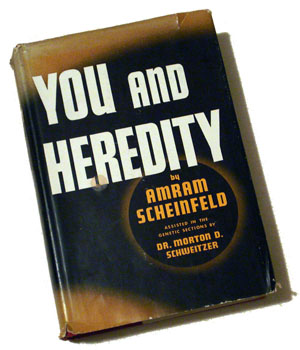September 13, 2009
 Amram Scheinfeld’s 1939 You and Heredity was a bestseller, a hit not only with the general public, but also with life scientists. It was rightly lauded as an excellent layperson’s primer on the state-of-the-art in human genetics and heredity, and a serious critique of the racist, nativist and even anti-homosexual sentiments common among early eugenics supporters.
Amram Scheinfeld’s 1939 You and Heredity was a bestseller, a hit not only with the general public, but also with life scientists. It was rightly lauded as an excellent layperson’s primer on the state-of-the-art in human genetics and heredity, and a serious critique of the racist, nativist and even anti-homosexual sentiments common among early eugenics supporters.
High school biology textbook authors immediately attached You and Heredity as a “further reading” to chapters on human inheritance, though they continued to mix it in with older, more hard line eugenic texts like Henry H. Goddard’s The Kallikak Family and Ellsworth Huntington’s Tomorrow’s Children.
Scheinfeld’s “breakthrough” thesis was that human behavior is governed not just by biological genes, but also by “social genes.” Scheinfeld suggested these “social genes” were much more critical to human behavior than early eugenicists thought. And that unlike beneficial biological genes, of which scientists still knew little, beneficial “social genes” were easy to identify and could be selected for simply by improving the environment.
But despite its many strengths, You and Heredity did not stray far from traditional assumptions regarding the general class distribution of “good” and “bad” genes. Though Scheinfeld believed it was impossible to know how any single individual, no matter how “badly born,” would ultimately turn out, he felt it was still critical to figure out some way of encouraging people who had good social genes, people not coincidentally like himself, to breed more and rebalance fertility rates.
Along with Frederick Osborn’s 1940 Preface to Eugenics, You and Heredity helped establish an ideological foundation upon which a more socially liberal generation of biologists, including Julian Huxley, Bentley Glass and Hermann Muller, could rebuild their defense of eugenics after the “setback” of the very public “misapplication” of its principals by Germany and other fascist regimes.
Scheinfeld’s “cake and eat it too” philosophy – you can’t judge the individual, but you can generally judge the group – supplied the slippery rationalization Osborn, Glass and others would employ to defend biology-based social management policies over the next three decades.
But Scheinfeld’s book contained a bomb, one Scheinfeld himself would trigger with his 1944 follow up, Women and Men.
Geneticist Bentley Glass called Women and Men “a better book than You and Heredity,” praising it as an unsurpassed “synthesis of genetic, anthropological, and sociological findings.”
However, Barnard sociologist and Second Wave feminist pioneer, Mirra Komarovsky, though sympathetic to Scheinfeld’s purpose, was critical. She noted that Scheinfeld’s frequent references to the “‘unique talents’ of women” and his omission of data on “overlapping” characteristics, undermined his conclusion that women should strive not to succeed in their field of choice, but seek the fullest expression of their own special “capacities” in occupations for which they are “‘suitable.’”
Komarovsky feared that Scheinfeld’s plea for full appreciation for the “special talents” of women would “be used to retard some sorely needed adjustments in the pattern of women’s lives, among them some of the very changes the author himself advocates.” In her critique, Komarovsky highlighted the faulty assumptions upon which all of reform eugenics was based.
Reform eugenicists raced in the years after World War II to adjust to shifting attitudes regarding race and class. Osborn and Glass thought they were ahead of the problem. However, by the 1970s, a growing awareness of gender as a social construct finally made eugenics, in any form, all but indefensible.
Proponents, despite their purported embrace of the overriding importance of “environment” and “training,” always presumed a sliding scale of genetic “fitness.” Though careful to avoid absolute classification, stating for example that pockets of special genetic talent might be found even within the darker races, reformers implied that people who were wealthier and whiter, or at least more “cultured,” were probably on average more genetically “progressed.”
But differences in human characteristics based on gender posed impossible questions.
Where does an educated upper class white woman, so obviously different to a male in her innate “capacities” according to Scheinfeld, sit on a eugenicist’s scale relative to, say, an African-American or a poor white man or the eugenicist himself?
Komarovsky was not the last woman who wanted to know.
REFERENCES
Glass, Bentley. 1945. “Women and Men.” The Quarterly Review of Biology 20:2.
Komarovsky, Mirra. 1945. “Women and Men.” American Sociological Review 10:2.
Scheinfeld, Amram. 1939. You and Heredity. New York: Frederick A. Stokes Company.
–. 1944. Women and Men. New York: Harcourt, Brace and Company.

1 Comment